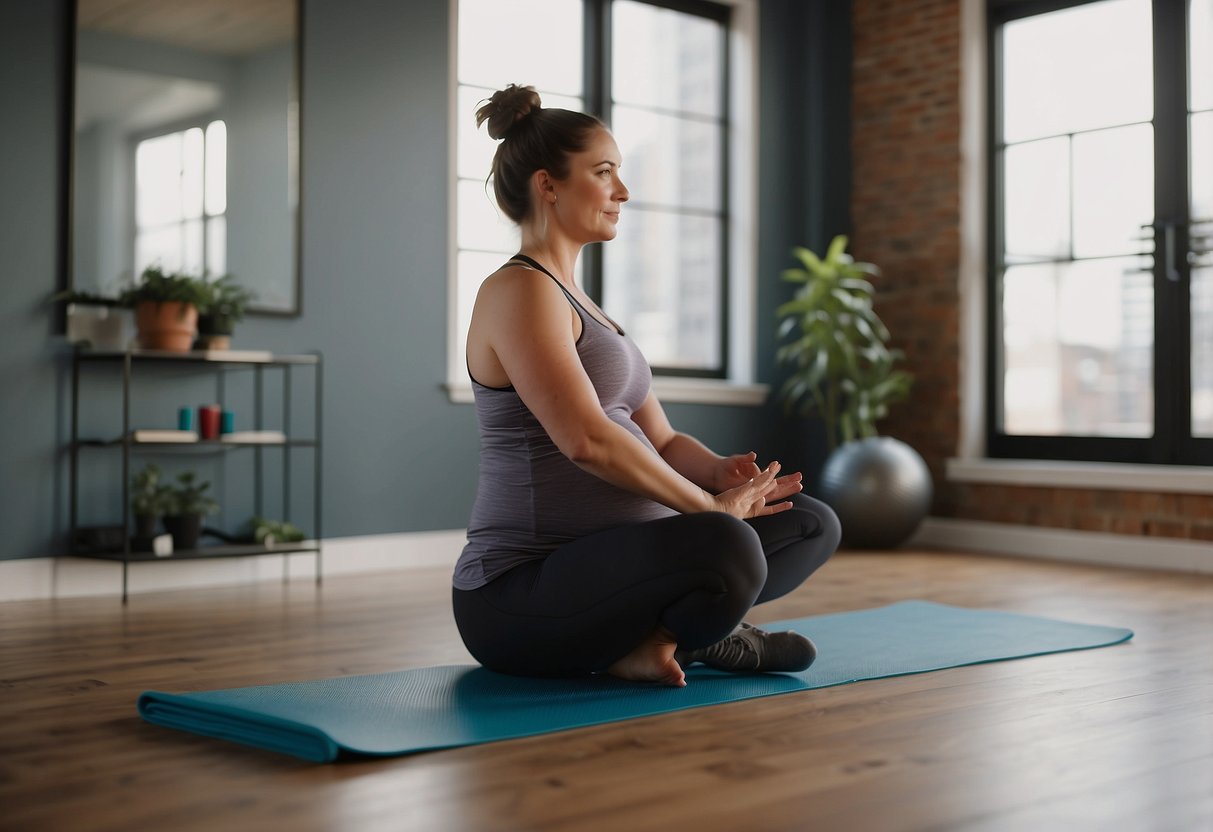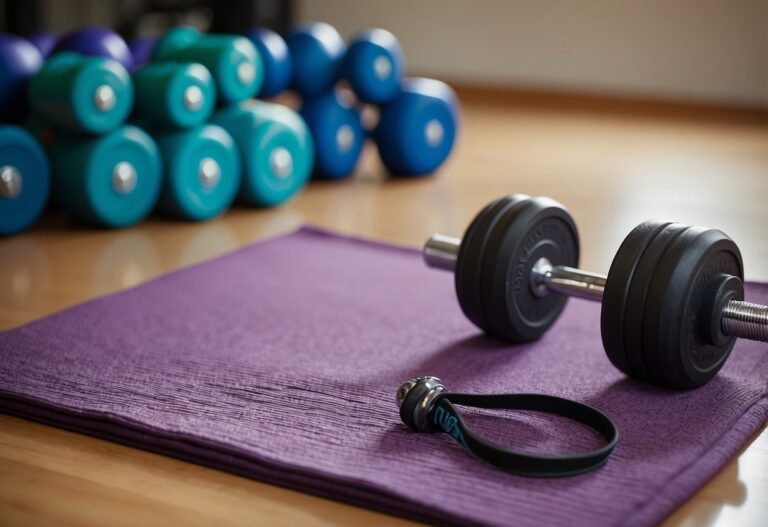Staying active during pregnancy is crucial for both you and your baby’s health. Regular exercise can boost your mood, reduce pregnancy discomfort, and even help with labour and delivery. It’s all about finding the right balance that suits your changing body and energy levels.

You’ll discover that many forms of exercise are not only safe but beneficial during pregnancy. Whether you love walking, yoga, or swimming, there’s something for everyone. By incorporating a few simple workout tips, you can maintain your fitness and wellbeing throughout your pregnancy.
Warm-up Stretches
Before you start your pregnancy workout, it’s important to warm up your muscles. This helps prevent injuries and prepares your body for exercise.
Begin with some half jacks. Unlike full jumping jacks, half jacks are gentle and safe. Step one leg out at a time while moving your arms in and out.
Try doing some heel digs. Tap your heels forward alternately and bend the opposite knee. Swing your arms forwards for balance.
A marching on the spot exercise is also effective. Lift your knees high and pump your arms. This increases your heart rate and gets your blood flowing.
Side leg raises are another great option. Stand straight and lift one leg to the side while balancing on the other. This helps strengthen your hips and improve stability.
Finally, do some ankle circles. Rotate each foot in circles. This loosens up your ankles and improves flexibility.
Always listen to your body and avoid pushing too hard. Warm-up stretches are key to a safe and effective pregnancy workout. For more warm-up ideas, you can check out this FittaMamma routine.
Prenatal Yoga
Prenatal yoga is a fantastic way to stay active during pregnancy. It can help lower your blood pressure and reduce stress levels. Studies show that doing yoga can be more effective than other low-impact exercises, like walking.
Certain yoga poses are specifically designed to help with pregnancy. For example, they can alleviate pelvic pain, ease tight hips, and reduce back pain. These poses also help prepare your body for labour.
Always consult with your healthcare provider before beginning any new exercise routine, including prenatal yoga. If you feel any discomfort, it’s important to listen to your body and adjust accordingly.
Many expectant mothers find that yoga helps their mental well-being too. If you’re feeling down or anxious, yoga might lift your spirits and bring a sense of calm.
Low-impact Aerobics
Low-impact aerobics can be a great way to stay fit during pregnancy. These exercises are easier on your joints, which is important as your body goes through many changes.
You might want to try classes specifically designed for pregnant women. These classes often focus on gentle movements that still give you a good workout.
Simple activities like walking or swimming are also excellent choices. They get your heart rate up without putting too much strain on your body. Always listen to your body and stop if you feel uncomfortable.
Pelvic Floor Exercises
Pelvic floor exercises are crucial during pregnancy. These exercises help strengthen the muscles supporting your bladder, bowel, and uterus.
You might notice these muscles come under a lot of strain, especially as your baby grows. Doing these exercises regularly can improve control and reduce the chances of urinary incontinence.
Start by sitting comfortably. Take deep breaths and imagine a flower gently opening. As you inhale, feel your pelvic floor relaxing.
Try stabilising yourself with a tall posture. Inhale, lift one leg to the side, and visualise lifting your pelvic floor.
Practising these steps can make a big difference. Remember to breathe normally throughout. More details can be found here.
Light weightlifting
Light weightlifting is great for staying fit during pregnancy. You can keep your muscles strong and prepare your body for childbirth. It’s important to use light weights and pay attention to your body’s signals.
Start with simple exercises like bicep curls and shoulder presses. These moves can be done with dumbbells of 2-5 kilograms. Focus on slow, controlled movements.
You might want to use resistance bands for exercises like rows and leg lifts. This adds a bit of resistance without overloading your muscles. Always ensure you use a supportive surface for any exercise lying down.
Remember to include rest periods and hydrate well throughout your workout. Your comfort and safety should always come first.
Water Aerobics
Water aerobics can be a fantastic workout for pregnant women. The water supports your belly, relieving pressure from your spine and pelvis. This makes it easier on your body compared to other forms of exercise.
Doing exercises like gentle pool aerobics or water walking helps use many of your muscles. This can lead to fewer exercise-related injuries and muscle strains.
It’s beneficial to warm up with a few gentle laps before your workout and cool down afterwards. This helps you ease in and out of the exercise.
If you’re new to swimming, consider asking a friend to join you. It’s also important to be aware of safety while in the water.
Make sure to consult your doctor before beginning any new workout routine. This ensures the exercises are safe for you and your baby.
Indoor Cycling
Indoor cycling is a safe and effective way to stay active during pregnancy. Compared to outdoor cycling, it reduces the risks associated with falls, traffic, and changing weather conditions.
Before starting, always check with your OB/GYN to ensure you have the green light to cycle. Every pregnancy is unique, and what works for one person might not work for you.
One of the benefits of indoor cycling is its low-impact nature. This makes it easier on your joints while still providing a good cardio workout. Plus, you can control the intensity to match your comfort level.
Adjusting your bike position is important. As your body changes, you might need to alter the seat or handlebar height to prevent discomfort.
Consider joining a prenatal indoor cycling class. Instructors can provide tailored advice and ensure that you’re cycling safely throughout your pregnancy.
Modified Planks
Doing planks during pregnancy can be safe if you modify them. You can start by placing your hands on an elevated surface like a kitchen counter or a sturdy chair. This will reduce the pressure on your abdomen and make it easier to maintain balance.
Another option is to perform wall planks. Stand a short distance away from a wall and place your forearms against it. Lean forward slightly while keeping your core engaged.
These variations help strengthen your core without putting too much strain on your body. It’s important to listen to your body and stop if you feel uncomfortable. Remember, staying active during pregnancy can keep you feeling strong and energised.
Pelvic Tilts
Pelvic tilts can be a game-changer during pregnancy. They help reduce back pain and improve posture. You can easily do them at home.
Begin on your hands and knees, keeping your back straight. Slowly arch your back upward and hold for a few seconds. Then, return to the starting position. This exercise helps stretch and strengthen your lower back muscles.
For a slightly different approach, perform pelvic tilts against a wall. Stand with your back against a wall and gently press your lower back into it by tilting your pelvis forward. Hold for a few seconds and then relax. This is great for maintaining mobility and reducing discomfort.
Don’t forget to practise regularly. Even just a few minutes a day can make a big difference in how you feel.
Side-lying Leg Lifts
Side-lying leg lifts are a great exercise for keeping your legs strong during pregnancy. This exercise targets your inner thighs and helps maintain flexibility.
To begin, lie on your side with your bottom leg straight and your top leg bent at a 90-degree angle. Your top leg should rest on the floor in front of you.
Lift your bottom leg up and down slowly. Keep your movements controlled and steady. Do this for 10-12 repetitions on each side.
Remember to breathe steadily and keep your core engaged throughout the exercise. This helps support your back and maintains good form.
Benefits of Pregnancy Workouts
Staying active during pregnancy brings many advantages. It can significantly enhance your physical health and mental well-being, as well as prepare you for labour.
Physical Health
Engaging in regular exercise can help you maintain a healthy weight throughout your pregnancy. It helps to manage weight gain which is beneficial for both you and your baby. Activities such as walking, swimming, and prenatal yoga are excellent choices. These exercises can also reduce the risk of gestational diabetes and high blood pressure.
Physical activity can also relieve common pregnancy-related aches and pains. For instance, stretching and strengthening exercises can alleviate back pain and improve your posture as your belly grows. Also, staying fit can improve your cardiovascular health, making daily tasks easier to manage as your pregnancy progresses. Regular workouts can boost your endurance, giving you more energy to get through each day.
Mental Well-being
Exercise isn’t just good for your body; it’s great for your mind too. Regular physical activity can help reduce stress and anxiety, which are common during pregnancy. It releases endorphins, the body’s natural mood lifters, helping you feel happier and more relaxed.
Engaging in activities like prenatal yoga can also enhance your mental focus and provide a sense of calm. These benefits can improve your sleep quality, making it easier to rest despite the physical discomforts of pregnancy. Participating in group exercise classes can also offer social support, helping you feel more connected to other mums-to-be.
Labour Preparation
Preparing your body for labour through regular exercise can make the birthing process smoother. Exercises designed to strengthen the pelvic floor muscles, such as Kegels, can help ease labour and reduce recovery time. Being in good shape can improve your stamina, which is crucial during the intense physical demands of childbirth.
Practising breathing exercises through activities like prenatal yoga can also be beneficial. These breathing techniques can help you stay calm and focused during labour. Additionally, staying active can increase your flexibility, making it easier for your body to position itself during delivery, potentially leading to a smoother birthing experience.
Regular exercise can empower you throughout your pregnancy journey, leading to a healthier and more enjoyable experience.
Safety Guidelines for Pregnancy Exercises
Staying active during pregnancy is important, but safety should always be your top priority. Checking in with your doctor, monitoring exercise intensity, and recognising when to stop are key to maintaining a healthy routine.
Consulting Your Doctor
Before starting any exercise routine, it is essential to speak with your doctor. This step is crucial because everyone’s pregnancy is different. Your doctor can provide personalised advice based on your health history and any complications you might have. They might suggest specific exercises or caution you against certain activities.
It’s also important to discuss any ongoing exercise routines. If you were already active before pregnancy, your doctor can help you modify your workouts to be safer. If you’re new to exercising, they can advise on how to start gradually.
Regular check-ups are essential. Use these opportunities to update your doctor on your exercise routine and discuss any new symptoms or concerns.
Appropriate Intensity Levels
Maintaining the right level of intensity is vital during pregnancy. A common guideline is the “talk test.” You should be able to carry on a conversation while exercising. If you’re too out of breath to talk, the intensity is probably too high.
Moderate-intensity activities like walking, swimming, and prenatal yoga are excellent choices. Avoid high-impact exercises, intense cardio, and activities that involve risks of falling, like cycling or skiing.
Hydration is key. Drink plenty of water before, during, and after exercise. Also, avoid exercising in hot weather to prevent overheating.
Signs to Stop Exercising
Listening to your body is critical when working out during pregnancy. There are specific signs that indicate you should stop exercising immediately. These include dizziness, shortness of breath, chest pain, muscle weakness, calf pain or swelling, vaginal bleeding, uterine contractions, and fluid leaking from the vagina.
If you encounter any of these symptoms, stop the activity at once and contact your doctor. It’s essential to differentiate between normal exercise fatigue and signs of a more serious issue.
By taking these precautions, you can keep active while protecting your health and your baby’s well-being.







